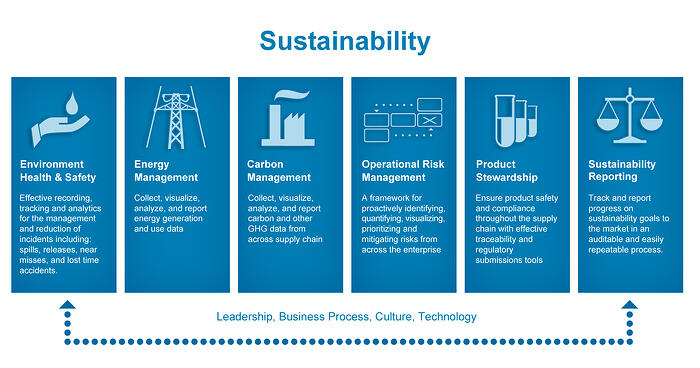Companies have always been focused on financial performance and achieving operational excellence. However, many companies are now striving to hold themselves to an even higher standard and it is all around sustainability.
As society evolves, industrial companies have no choice but to keep up with and manage this challenge. Driven by a number of ethical, environmental, health, and safety concerns, organizations are developing sustainability strategies to remain competitive in the market, uphold Corporate Social Responsibilities (CSR), and abide by regulations.
Similar to the topic of operational excellence we touch on so frequently, the complexities and importance of sustainability management are becoming too great for disparate systems and manual processes. Consequently, we’re beginning to see a shift toward a more holistic strategy in terms of people, processes, and technology: Enterprise Sustainability Management (ESM).
Enterprise Sustainability Management Broken Down
Before we can understand the concept of ESM, we should first drill down into the core components of sustainability. Emerging regulatory and societal pressures are changing the game for industrial companies, creating an increased focus on what LNS Research identifies as six distinct areas of sustainability:

Environment, Health, and Safety (EHS)
In response to an increasing number of environmental and public concerns, companies are putting EHS processes in place. This helps to identify non-conformances, put in place a root cause analysis and continuous improvement process, and mitigate risks associated with the effects of safety hazards to people, assets, products, and the environment.
Energy Management
By monitoring energy consumption, use, and efficiency data with energy management software and processes, industrial organizations are making better decisions for the environment and stakeholders. Energy management can be done at multiple levels of granularity (plant down to machine), providing the needed data for reducing costs and environmental impacts.
Carbon Management
With such significant focus on the effects of greenhouse gases, carbon is a rising factor in regulatory decisions and it's receiving increased attention in the industrial setting. Similar to energy management, its processes are being used to improve business performance and protect the environment across the value chain.
Providing visibility into operations, ORM is being utilized to establish risk-related business processes, manage change, monitoring risk analytics, and leverage the effectiveness of Corrective and Preventive Actions (CAPA).
Product Stewardship
Focused around creating environmentally friendly manufacturing and industrial processes and products, product stewardship is the concept of taking a sustainability-based approach to the product lifecycle and supply chain
Sustainability Reporting
Reporting is an important aspect of sustainability management. To monitor consumption levels, quickly respond to audits (internal and external), and make measurable improvements, companies must have strong Business Intelligence capabilities. Many companies are now managing sustainability reporting with same precision and rigor as with financial reporting.
Facilitating Enterprise Sustainability Management with Technology
ESM is best thought of as a strategic framework for information management and it has evolved as a response to the growing need for holistically managing sustainability at the enterprise level. Industrial organizations have traditionally managed these processes in an ad hoc way at the facility and departmental level. For example, different people and departments would often be responsible for energy, carbon, and environmental compliance, making it very difficult for executives to have a clear picture of what was going on with the organization.
For many industrial companies, the disjointedness of ad hoc processes is creating a bottleneck when it comes to improving business performance. The need for a more pervasive solution is quickly becoming apparent, and it’s materializing as ESM. Companies taking this approach are viewing it through the lens of an enterprise initiative, rather than one of departments or business units.
Aiding the effectiveness of ESM is an emerging software category for Enterprise Sustainability Management solutions. Breaking down the barriers of disparate systems and manual processes, ESM software is centralizing, standardizing, and streamlining operations, providing executives with real-time data for making better decisions. In the coming months, LNS Research will be covering this topic in-depth, launching both our sustainability survey and section of the research library.
Additionally, on Wednesday, October 17, at 11a.m. (EST), we are participating in a webcast discussing the move toward a unified sustainability information system. LNS Research's President and Principal Analyst will be joined by a number of industry leaders from ERM, OSIsoft, and IHS. We hope to see you there!
You might also be interested in:
Sustainable Manufacturing: Strategies for Energy Management
Sustainability Definition | More than CSR
The LNS Research Approach: Share, Learn, and Improve
